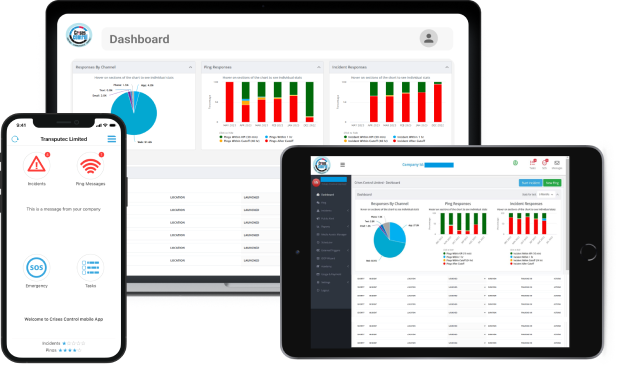Written by Anneri Fourie | Crises Control Executive
Workplace safety is often viewed as a compliance requirement, something businesses must do to meet regulations. But beyond legal obligations, workplace incidents carry hidden costs that can significantly impact your bottom line. From operational downtime and reputational damage to increased insurance premiums and productivity losses, the true financial impact of workplace incidents is often underestimated.
This is where Workplace Safety Software makes a difference. By proactively managing risks, streamlining safety processes, and ensuring compliance, businesses can protect their employees while also safeguarding their financial stability.
In this blog, we’ll explore the hidden financial costs of workplace incidents, how Crises Control helps businesses reduce risks, and why having a structured approach to incident management is essential for minimising disruptions and protecting both employees and the bottom line.
The True Cost of Workplace Incidents
Many businesses focus on the direct costs of workplace incidents, compensation claims, medical expenses, and potential legal fees. While these can be significant, they often pale in comparison to the indirect costs, which can continue to affect the business long after the initial incident.
Direct Costs of Workplace Incidents
- Medical Expenses: Immediate treatment, long-term rehabilitation, and compensation for injuries.
- Regulatory Fines: Businesses face heavy penalties for failing to meet health and safety standards.
- Legal Fees: Lawsuits from employees, contractors, or third parties can lead to expensive settlements.
Indirect Costs of Workplace Incidents
- Productivity Loss: Work stoppages, absenteeism, and reduced morale lead to operational inefficiencies.
- Increased Insurance Premiums: Frequent incidents result in higher liability insurance costs.
- Reputational Damage: Negative press and poor safety records can affect customer trust and investor confidence.
- Operational Disruptions: Downtime caused by safety failures leads to missed deadlines, lost revenue, and dissatisfied clients.
A single workplace accident can set off a chain reaction of financial consequences that many companies fail to anticipate.
How Workplace Safety Software Reduces Financial Risks
Preventing workplace incidents isn’t just about meeting regulations – it’s about strengthening business resilience. A structured, proactive approach to managing safety risks helps businesses reduce financial exposure, protect employees, and ensure smooth operations.
1. Preventing Incidents Through Risk Assessment
Identifying hazards before they escalate is essential for preventing accidents and minimising losses. By proactively assessing risks, businesses can:
- Spot High-Risk Areas: Identify potential dangers through real-time safety audits.
- Streamline Risk Assessments: Use data-driven insights to detect safety trends and address concerns before they escalate.
- Assign Corrective Actions: Ensure safety teams take immediate action to prevent small issues from turning into costly incidents.
A proactive approach to safety reduces incident likelihood, safeguarding both employees and financial stability.
2. Faster Incident Response and Management
No matter how well safety measures are in place, incidents can still occur. When they do, an effective incident response process is key to minimising disruption. A well-organised system helps:
- Automated Alerts: Notify the right personnel immediately, cutting down response time.
- Incident Logging & Reporting: Capture incident details, assign tasks, and track resolution for a clear overview.
- Mobile Accessibility: Enable employees to instantly report hazards from any location.
A swift response helps reduce downtime, stopping small incidents from becoming major disruptions.
3. Ensuring Compliance and Avoiding Legal Liabilities
Non-compliance with health and safety regulations can result in heavy fines and legal trouble. Keeping track of safety procedures and compliance becomes easier when businesses can:
- Maintain Digital Records: Store safety documentation securely, simplifying audits and inspections.
- Automate Training Reminders: Ensure employees are up-to-date with their health and safety training requirements.
- Generate Real-Time Reports: Meet regulatory standards such as ISO 45001 and HSE regulations without added stress.
Streamlining compliance helps avoid penalties and maintain a strong safety record, protecting the business from legal issues.
4. Minimising Operational Disruptions and Downtime
Every workplace incident causes some level of disruption, but a well-organised system can ensure business continuity even in the midst of unforeseen events. For smooth operations, businesses can:
- Automate Safety Workflows: Reduce delays caused by manual processes.
- Provide Mass Notification Capabilities: Quickly alert employees of hazards to minimise confusion and downtime.
- Enable Task Management Features: Ensure corrective actions are completed promptly, with clear accountability.
By reducing response times and improving coordination, businesses can maintain normal operations even during incidents.
5. Boosting Employee Confidence and Retention
A workplace safety programme not only protects your business, but also contributes to a positive work environment. When employees feel safe, they’re more likely to stay engaged and committed to their roles. Workplace safety measures help by:
- Providing a Self-Reporting System: Empower employees to report hazards or concerns easily.
- Ensuring Swift Management Responses: Demonstrate commitment to safety by addressing concerns quickly.
- Reducing Workplace Stress: A safer environment leads to higher morale, reduced turnover, and a more productive workforce.
Investing in workplace safety fosters trust, boosts productivity, and ultimately reduces staff turnover.
How Crises Control Helps You Save Money and Protect Employees
Crises Control provides a comprehensive Workplace Safety Software solution that helps businesses prevent incidents, respond effectively, and maintain compliance.
1. Real-Time Incident Management
With Crises Control, businesses can instantly notify employees of an emergency, assign response teams, and track progress in real time. The Incident Management Software ensures a structured response, reducing downtime and financial losses.
2. Automated Compliance and Reporting
Crises Control simplifies compliance management with:
- Digital safety records for audits.
- Automated safety training reminders.
- Real-time reports to meet industry regulations.
3. Mass Notification System for Immediate Alerts
During emergencies, rapid communication is crucial. Crises Control’s Mass Notification System ensures employees receive alerts via mobile, email, SMS, and desktop notifications, helping businesses avoid confusion and delays.
4. Task Manager for Safety Protocol Execution
Managing safety tasks manually is inefficient. Crises Control’s Task Manager ensures all safety actions are assigned, tracked, and completed on time, reducing human error and improving compliance.
5. Customisable Safety Workflows
Every business has unique safety requirements. Crises Control allows organisations to tailor safety workflows, ensuring compliance with industry-specific risks and challenges.
“Our priority is to get information out clearly and concisely to our staff and to prompt them to respond quickly. That’s why we find the Ping message acknowledgment feature extremely powerful. They hit the button and get on with their lives, we are satisfied, and they are safe. Thanks to its intuitive design, the platform is very easy for administrators and keyholders to use. It’s very obvious what you have to do. You don’t need long explanations.” – Anthony Butler | Senior Manager, ITOCHU Europe Plc
Conclusion: Protect Your Business from the Hidden Costs of Workplace Incidents
Workplace incidents cost more than most businesses realise. The hidden expenses, including lost productivity, legal liabilities, and operational disruptions, can cripple a business if not properly managed.
Investing in Workplace Safety Software is not just about compliance; it is a strategic decision to protect employees, reduce financial risks, and ensure business continuity.
Crises Control provides an industry-leading safety solution that helps businesses identify risks, streamline incident response, and automate compliance.
Don’t wait for an incident to expose the hidden costs, contact us today and take control of your workplace safety.
Request a FREE Demo









